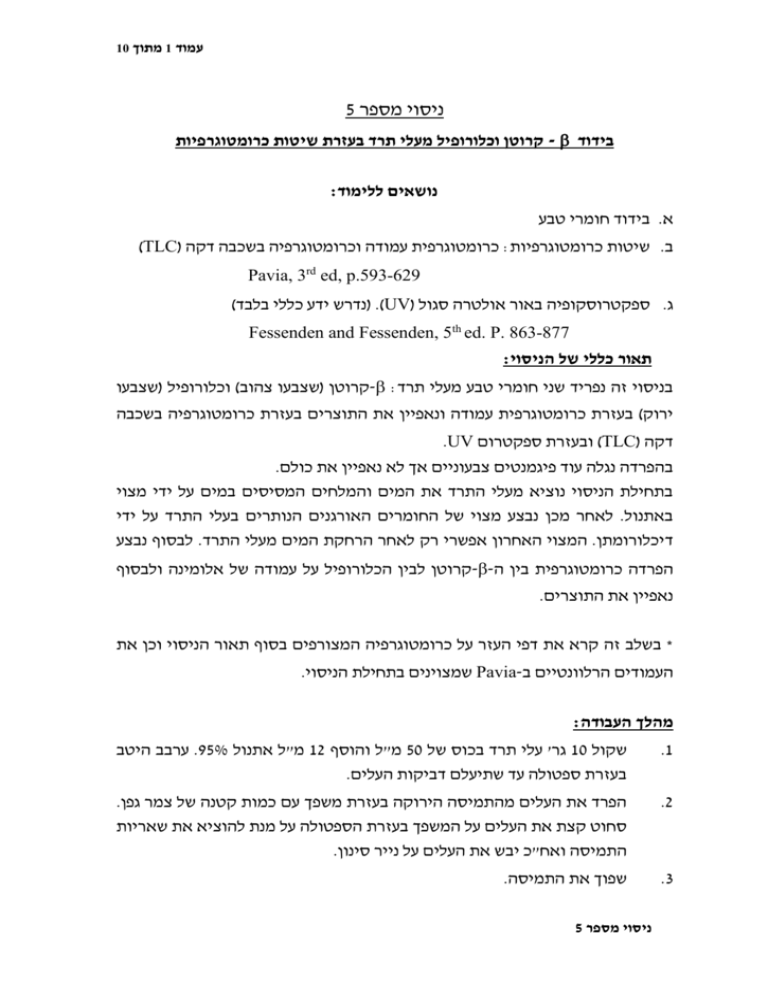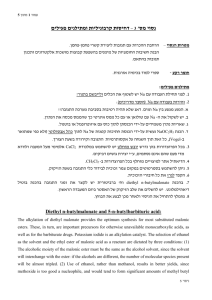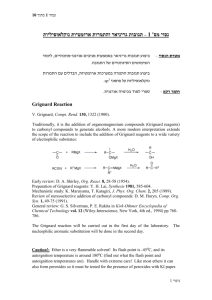ניסוי מספר 5 Isolation of β- Carotene column Chromatography
advertisement

עמוד 1מתוך 10 ניסוי מספר 5 בידוד - קרוטן וכלורופיל מעלי תרד בעזרת שיטות כרומטוגרפיות נושאים ללימוד: א .בידוד חומרי טבע ב .שיטות כרומטוגרפיות :כרומטוגרפית עמודה וכרומטוגרפיה בשכבה דקה ()TLC Pavia, 3rd ed, p.593-629 ג .ספקטרוסקופיה באור אולטרה סגול (( .)UVנדרש ידע כללי בלבד) Fessenden and Fessenden, 5th ed. P. 863-877 תאור כללי של הניסוי: בניסוי זה נפריד שני חומרי טבע מעלי תרד- :קרוטן (שצבעו צהוב) וכלורופיל (שצבעו ירוק) בעזרת כרומטוגרפית עמודה ונאפיין את התוצרים בעזרת כרומטוגרפיה בשכבה דקה ( )TLCובעזרת ספקטרום .UV בהפרדה נגלה עוד פיגמנטים צבעוניים אך לא נאפיין את כולם. בתחילת הניסוי נוציא מעלי התרד את המים והמלחים המסיסים במים על ידי מצוי באתנול .לאחר מכן נבצע מצוי של החומרים האורגנים הנותרים בעלי התרד על ידי דיכלורומתן .המצוי האחרון אפשרי רק לאחר הרחקת המים מעלי התרד .לבסוף נבצע הפרדה כרומטוגרפית בין ה--קרוטן לבין הכלורופיל על עמודה של אלומינה ולבסוף נאפיין את התוצרים. * בשלב זה קרא את דפי העזר על כרומטוגרפיה המצורפים בסוף תאור הניסוי וכן את העמודים הרלוונטיים ב Pavia-שמצוינים בתחילת הניסוי. מהלך העבודה: .1 שקול 10גר' עלי תרד בכוס של 50מ"ל והוסף 12מ"ל אתנול .95%ערבב היטב בעזרת ספטולה עד שתיעלם דביקות העלים. .2 הפרד את העלים מהתמיסה הירוקה בעזרת משפך עם כמות קטנה של צמר גפן. סחוט קצת את העלים על המשפך בעזרת הספטולה על מנת להוציא את שאריות התמיסה ואח"כ יבש את העלים על נייר סינון. .3 שפוך את התמיסה. ניסוי מספר 5 עמוד 2מתוך 10 .4 הכנס את עלי התרד לכוס של 50מ"ל והוסף 10מ"ל דיכלורומתן (מתילן כלוריד) .ערבב במשך 2דקות וסנן בעזרת משפך עם צמר גפן לאביק של 50מ"ל. .5 זרוק את עלי התרד ושמור את התמיסה במקום אפל או עטופה בנייר כסף עד שהעמודה תהיה מוכנה להפרדה. .6 לפני ביצוע הכרומטוגרפיה נדף עד יובש באוופורטור ) (Evaporatorאת החומר שנמצא באביק .דיכלורומתן מתנדף בקלות אך יש להיזהר לא לחמם יותר מדי כדי למנוע פירוק התוצרים. .7 קרר את הכלי והוסף לחומר היבש 10טיפות פטרול-אתר ו 10-טיפות דיכלורומתן עד להמסת החומרים .החומר מוכן עכשיו להפרדה. .8 שמור כמה טיפות מהתערובת לבדיקת .TLC הכנת העמודה( :יש לעבוד במנדף!!!) הכן את העמודה על ידי סתימת הקצה התחתון במעט צמר גפן ומעליו שכבת חול בגובה של כ 0.5-ס"מ .הוסף כ 10-מ"ל של פטרול-אתר .שקול 16גר' אלומינה בכוסית .הכנס 30מ"ל פטרול-אתר בארלנמאייר של 100מ"ל והוסף את האלומינה לתוך הפטרול- אתר במנות קטנות תוך ערבוב עד שנוצרת דייסה ואז הכנס אותה במהירות לעמודה. העמד ארלנמאייר מתחת לעמודה ופתח את הברז להעברת הממס לעמודה .תוך כדי כך דפוק בזהירות על דפנות העמודה באצבעותיך .החזר את הנוזל שהעברת לכלי עם שארית האלומינה והעבר שוב דרך העמודה .כך עד שתיווצר עמודה בגובה של כ15- ס"מ .הוסף שוב חול בגובה של 5-3מ"מ. אל תיתן לעמודה להתייבש .פני העמודה חייבים להיות מכוסים תמיד במעט ממס (בגובה של 2ס"מ) כדי למנוע התייבשות. הפרדה: כאשר העמודה מוכנה ,הכנס לתוכה בעדינות בעזרת פיפטת פסטר את התערובת שהכנת (האם שמרת כמה טיפות ל .)?TLC-פתח את הברז ותן לתמיסה להיכנס לעמודה וסגור שוב את הברז .בעזרת פיפטת פסטר שטוף בכמות קטנה ביותר של פטרול-אתר את דפנות העמודה והכנס את החומר פנימה .שוב סגור את הברז .המתן כ- 5דקות .שמור כל הזמן שהעמודה תהיה מכוסה במעט ממס .הכן 40מ"ל תמיסת מריץ 95% :פטרול אתר ו 5% -אתיל אצטט והכנס לעמודה. התחל באיסוף מנות של 5מ"ל לתוך מבחנות ובמקביל הוסף ממס לעמודה עצמה. בתחילה יצא מעט ממס אך עד מהרה יתחיל לרדת -קרוטן צהוב בעוד שהכלורופיל הירוק ינוע במהירות הרבה יותר איטית על העמודה .כאשר רוב החומר הצהוב יעבור ניסוי מספר 5 עמוד 3מתוך 10 את העמודה החלף את הממס לתערובת של 50%פטרול-אתר ו 50%-אתיל-אצטט .זה יגרום ליציאה מהירה יותר של המקטע הירוק .אם היציאה של המקטע הירוק איטית מדי ,אפשר להחליף את תמיסת המריץ ל 90% :אתיל אצטט ו 10% -מתנול( .הכן כ30 - מ"ל תמיסה). פרוט בדיקת :TLC ( )Iבאופן כללי יש להקפיד על הכנת תמיסות מהולות של החומרים הנבדקים ב ,TLC כמות של כ 2-3 -מ"ג חמר ב 1-2 -מ"ל ממס .במקרה שלנו הוסף כמות קטנה ביותר של דיכלורומתן לאביק אחרי הנידוף. ( )IIהקפד לשים את התמיסה הנבדקת על הפלטה בעזרת קפילרה דקה ,וליצור נקודה אחת בקטר של 2-3מ"מ בלבד .אין צרך לשים יותר מאשר טיפה אחת בכל נקודה (במידה והתמיסה מהולה – צבעה בהיר למדי – מומלץ לשים מספר טיפות באותה נקודה) .הקפד שנקודות המוצא תהיינה לפחות 5מ"מ משולי הפלטה ובגובה של 1ס"מ מעל תחתית הפלטה. וודא שהמרחק בין הנקודות יהיה כזה שימנע חפיפה בין הדוגמאות ( 6-7מ"מ). אין לסמן קו התחלה ,ובודאי לא לחרוץ חריץ בקו ההתחלה של הפלטה. ( )IIIיש להכין קו סיום (בחלק העליון של הפלטה) טרם הכנסת הפלטה לכוסית עם התמיסה המריצה. ( )IVהנוזל המפתח הוא 80%פטרול אתר ו 20% -אתיל אצטט. הכן 20מ"ל של הנוזל המפתח בכוסית של 250מ"ל. ( )Vהכנס את הפלטה לכוסית אך אין לטבול את נקודות ההתחלה על הפלטה בתוך הממס .כסה את הכוסית בצלחת פטרי. ( )VIאין לטלטל את הכוס עם הפלטה בזמן ההרצה. ( )VIIשים לב -מכיוון שהחומרים שבודדת אינם יציבים ,הנקודות על פלטת ה TLC עלולות להיעלם .לכן ,סמן בעיפרון את מקום הנקודה מיד לאחר הפיתוח .חשב את ערך ה Rf-עבור כל נקודה -עבור הדוגמאות לפני ואחרי ההפרדה .לבסוף בצע ספקטרום UVלשני התוצרים המופרדים והשווה עם הספקטרום הנתון. ניסוי מספר 5 עמוד 4מתוך 10 אפיון התוצרים על ידי ספקטרום :UV .1קבל מהמדריך הסבר על פעולת המכשיר. .2בדוק את ספקטרום ה UVשל התוצרים שהפרדת בפטרול אתר כממס ,והשווה לספקטרום הנתון: ניסוי מספר 5 10 מתוך5 עמוד CHROMATOGRAPHY (Encyclopedia Britannica): Technique for separating the components, or solutes, of a mixture on the basis of the relative amounts of each solute distributed between a moving fluid stream, called the mobile phase, and a contiguous stationary phase. The mobile phase may be either a liquid or a gas, while the stationary phase is either a solid or a liquid. The chromatographic separation process is based on the difference in the surface interactions of the analyte and the eluent molecules. For example: • • Component A: interaction with adsorbent is as strong as for eluent molecules. Component B: strong excessive interaction with adsorbent. Result: • • • Component A moves trough the column with the same speed as eluent molecules. Component B moves slower than the eluent flow. Since the eluent flow is different we may separate the compounds by collecting the eluate at different times. For references on chromatography see (the first two books are for the more curious students, the last two books are obligatory to understand what you will be doing): ‘The essence of chromatography’ Colin F. Poole ‘Practical problem solving in HPLC’ Stavros Kromidas ‘Introduction to organic laboratory techniques. A small scale approach’ 2nd Ed. Donald L. Pavia, Garry M. Lampman, George S. Kriz, Randall G. Engel ‘Vogel’s textbook of practical organic chemistry’ 5th Ed. Chapter 2.31 S. Furniss, A.J. Hannaford, P.W.G. Smith and A.R. Tatchell 5 ניסוי מספר 10 מתוך6 עמוד Historical Background • • The Russian botanist M.S. Tswett ‘discovered’ chromatography in 1903 (Lederer rediscovered it in 1931 and it never looked back). In 1906 Mikhail coined the term chromatography: “Just like the rays of light in the spectrum, so are the different components of a pigment mixture separated in an orderly way in the calcium carbonate column and thus may be qualitatively and also quantitatively determined. Such a preparation I call a chromatogram and the corresponding method, the chromatographic method” "UP TO NOW, WE HAVE LEARNED WITH MUCH EFFORT TO DISTILL, CYRSTALLIZE, AND RECRYSTALLIZE, AND NOW THEY COME ALONG AND JUST POUR THE STUFF THROUGH A LITTLE TUBE!" M.S. Tswet • A.J.P. Martin Important contributors include: A.J.P. Martin and R.L.M Synge (Nobel Prize 1952 for partition chromatography); A. T. James and Martin (gas-liquid chromatography, 1952); Porath (Size exclusion chromatography, 1958 and affinity chromatography, 1967) See also H.J. Issaq, A Century of Separation Science, Dekker, New York, 2001. “I would like to take this opportunity to record here my belief that one should take a minimum of care and preparation over first experiments. If they are unsuccessful one is not then discouraged since many possible reasons for failure can be thought of, and improvements can be made. Much can often be learned by the repetition under different conditions, even if the desired result is not obtained. If every conceivable precaution is taken at first, one is often too discouraged to proceed at all.” A.J.P. Martin, Nobel Lecture 5 ניסוי מספר 10 מתוך7 עמוד Thin Layer Chromatography (TLC) TLC is a simple, quick, and inexpensive procedure that gives the chemist a quick answer as to how many components are in a mixture. TLC is also used to support the identity of a compound in a mixture when the Rf of a compound is compared with the Rf of a known compound (preferrably both run on the same TLC plate). A TLC plate is a sheet of glass, metal, or plastic which is coated with a thin layer of a solid adsorbent (usually silica or alumina). A small amount of the mixture to be analyzed is spotted near the bottom of this plate. The TLC plate is then placed in a shallow pool of a solvent in a developing chamber so that only the very bottom of the plate is in the liquid, it’s extremely important that the vapor phase and liquid phase be in total equilibrium, for this we need a closed chamber. This liquid, or the eluent, is the mobile phase, and it slowly rises up the TLC plate by capillary action. As the solvent moves past the spot that was applied, an equilibrium is established for each component of the mixture between the molecules of that component which are adsorbed on the solid and the molecules which are in solution. In principle, the components will differ in the strength of their adsorption to the adsorbent and some components will be carried farther up the plate than others. When the solvent has reached the top of the plate, the plate is removed from the developing chamber, dried, and the separated components of the mixture are visualized. If the compounds are colored, visualization is straightforward. Usually the compounds are not colored, so a UV lamp or other methods are used to visualize the plates. (The plate itself contains a fluorescent compound, typically fluorescein, which fluoresces everywhere except where a UV absorbing organic compound is on the plate, that’s why we see a dark spot where the compounds are.) The retention factor, or retardation factor, Rf, is defined as the distance traveled by the compound divided by the distance traveled by the solvent. The Rf for a compound is a constant from one experiment to the next only if the chromatography conditions below are also constant: -Solvent system -Adsorbent -Thickness of the adsorbent -Amount of material spotted -Temperature and humidity -Geometry of the TLC bath 5 ניסוי מספר 10 מתוך8 עמוד Since it’s very difficult to control precisely all these parameters unknown TLC analyses are usually run together with a control (usually one or more spots for starting material/s, one spot for the reaction mixture and one co-spot, both starting material and reaction mixture together, think why this is). green background 5 ניסוי מספר 10 מתוך9 עמוד Flash Chromatography The most widely used technique to separate compounds in a synthetic organic laboratory is by Clark Still’s method of flash chromatography. The use of pressure to speed up the separation not only saves time but also significantly improves the resolution and separation efficiency of the chromatography. The method allows separations of samples weighing 0.01-10.0 grams in 10-15 minutes. The method is summarized below, for a full account see Still et. al, J. Org. Chem. 1978, 43, 2923-2925. (1) A solvent is chosen which gives good separation and moves the desired component to Rf = 0.35 on analytical TLC (this is very important, as well as running the TLC correctly as detailed above). The most used solvent systems are mixtures of 30-600C petrol ether with ethyl acetate due to their low toxicity, wide range of polarities and low boiling points for easy evaporation. (2) A column of the appropriate diameter (see Table I) is selected and filled with 5-6 in. of dry 40-63 m silica gel (this silica gel is typically known as flash silica, the size of the particles is very important, larger sizes like 63-200m do not give good results). (3)The column is filled with solvent and pressure is used to rapidly push the air from the silica gel. (4) The sample is carefully applied (in the minimum volume possible) without disturbing the surface and the column is refilled with solvent and eluted at a flow rate of 5 cm/min. The time required to elute the desired components from the column is generally so fast (5-10 min) that a simple rack holding forty 20 X 150 mm test tubes is used to collect fractions. Small fractions are typically collected early in the elution with larger ones being collected toward the end of the chromatography. Separated components are conveniently detected by spotting ~5 L of each fraction along the long side of 7 cm X 2.5 cm TLC plate and then by developing the plate sideways. Heavier spotting or larger plates may be required for small samples, highly retentive components or harder separations. In conclusion, flash chromatography provides a rapid and inexpensive general method for the preparative separation of mixtures requiring only moderate resolution. Even in cases where high resolution is required, preliminary 5 ניסוי מספר 10 מתוך10 עמוד purification by the flash technique allows simplified high-resolution separations without contamination of expensive HPLC columns. 5 ניסוי מספר

